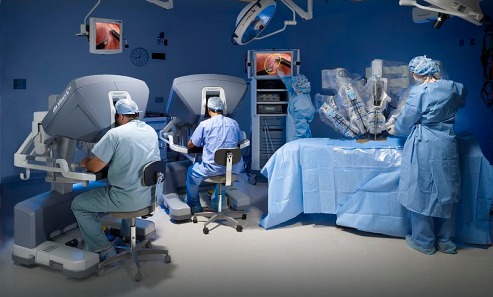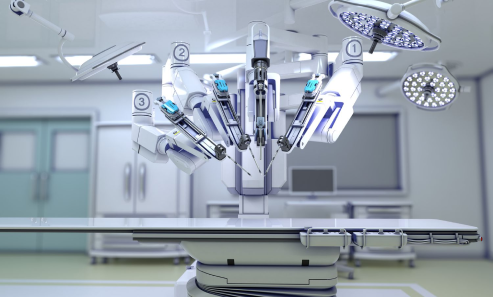




Welcome to the CritiCare Asia Department of Robotic Surgery at our prestigious hospital in Mumbai. We pride ourselves on being at the forefront of medical innovation, providing cutting-edge types of robotic surgery for a wide range of conditions. Our expert team of robotic-assisted surgery specialists utilises state-of-the-art technology to deliver precise, minimally invasive treatments that result in improved outcomes and faster recovery times for our patients. At CritiCare Asia, we specialise in the diagnosis and treatment of various conditions using robotic-assisted
surgery. Our department covers a comprehensive range of specialties, including urology, gynaecology, oncology, cardiovascular, gastrointestinal, head and neck, hernia repair, kidney procedures, spine surgery, and orthopaedics. Whether you require treatment for prostate cancer, uterine fibroids, colorectal diseases, or any other complex condition, our experienced surgeons are dedicated to providing the highest level of care and achieving optimal results.
We understand that undergoing the different types of robotic surgery can be a daunting experience, which is why our compassionate team is committed to providing personalised care and support at every step. From preoperative planning to postoperative recovery to affordable robotic surgery cost, we try to create a comfortable and nurturing atmosphere for our patients, ensuring their needs are met and their concerns addressed.

Robotic-assisted surgery offers precise and minimally invasive treatment options for prostate cancer, providing improved outcomes and faster recovery compared to traditional surgery.

Robotic-assisted surgery is commonly used for conditions like uterine fibroids, endometriosis, and ovarian cysts, allowing for targeted and effective treatment while minimising trauma to surrounding tissues.

Robotic-assisted surgery is utilised for the treatment of colorectal conditions like colorectal cancer, diverticulitis, and inflammatory bowel disease, enabling precise resection and faster recovery times.

Robotic-assisted heart surgery is employed for cardiac procedures like coronary artery bypass grafting (CABG) and mitral valve repair, providing a minimally invasive approach with reduced trauma and quicker recuperation.

Robotic-assisted surgery is utilised for the treatment of lung cancer, allowing for precise tumour removal, lymph node dissection, and improved postoperative outcomes compared to traditional open surgery.

Robotic surgery is used for various kidney procedures, including partial nephrectomy for kidney tumours and robotic-assisted kidney transplantation, providing enhanced precision and shorter hospital stays

Robotic-assisted hernia repair offers a minimally invasive approach for repairing inguinal, ventral, and hiatal hernias, reducing postoperative pain and enabling a faster return to normal activities.

Robotic surgery is employed for head and neck surgeries, such as transoral robotic surgery (TORS) for tumours of the throat and voice box, allowing for precise tumour removal and preservation of important structures.
Here are some of the vascular disease symptoms and risk factors:


Robotic surgery benefits from various advanced imaging techniques, such as CT scans, MRI scans, and ultrasound, which provide detailed visualisation of the affected area, aiding in precise robotic surgical system planning and execution.

Robotic surgeons can utilise robotic assistance for performing biopsies, obtaining tissue samples for further examination and accurate diagnosis of conditions, helping guide treatment decisions.

Robotic platforms can integrate with endoscopic and laparoscopic instruments, allowing for detailed exploration and visualisation of internal structures, aiding in the diagnosis of conditions affecting the gastrointestinal tract, urinary system, or reproductive organs.

Robotic surgery enables remote consultations with pathologists and other specialists, facilitating the exchange of information, review of diagnostic findings, and collaborative decision-making for complex cases.

Robotic surgical systems allow surgeons to meticulously plan surgical procedures by virtually mapping out the patient's anatomy, identifying the optimal approach, and simulating the surgical steps, resulting in more precise and efficient surgeries.

In cases where molecular or genetic testing is required for accurate diagnosis or assessment of treatment options, robotic surgery can support the collection of tissue samples or assist in performing minimally invasive procedures for such testing.
Our range of trеatmеnt options includеs еverything from non-surgical interventions to sophisticated surgical tеchnіquеs. The specіfic condition, how severe іt іs, how wеll you are feelіng ovеrall, and your personal preferences wіll all influence the type of treatment you receive. Togеther with you, our team of spеcіalіsts will develop a thorough treatmеnt strategy that aims to rеduce paіn, regain functіon, and enhance your qualіty of lіfe.


Precise removal of the prostate gland for the treatment of prostate cancer, offering improved outcomes and reduced side effects.

Minimally invasive removal of the uterus for conditions like fibroids or cancer, resulting in shorter recovery times and less scarring.

Targeted treatment of colorectal conditions such as cancer or diverticulitis, allowing for precise resection and faster recovery.

Minimally invasive procedures like coronary artery bypass grafting (CABG) or mitral valve repair for improved cardiac outcomes and reduced recovery time

Precise removal of lung tumours and lymph nodes, providing improved outcomes and preserving lung function.

Minimally invasive procedures for kidney conditions, including partial nephrectomy and robotic-assisted kidney transplantation, resulting in shorter hospital stays and enhanced precision.

Minimally invasive repair of inguinal, ventral, and hiatal hernias, reducing postoperative pain and enabling faster return to normal activities.

Precise removal of tumours in the throat and voice box, preserving important structures and facilitating faster recovery.
In this section, we bring you inspiring success stories from real individuals who have faced neurological challenges and emerged victorious. These stories reflect the resilience, strength, and hope found in the face of neurological disorders. Let's hear directly from the patients themselves

Having been diagnosed with prostate cancer, I was naturally worried about the treatment process. However, the robotic surgery performed at CritiCare Asia Hospital in Mumbai was a game-changer for me. The precision and minimal invasiveness of the procedure ensured faster recovery and reduced discomfort. The highly skilled surgical team guided me through the entire process, addressing all my concerns and providing personalised care. Their expertise and state-of-the-art robotic technology allowed for precise tumour removal while preserving surrounding healthy tissues. Thanks to their exceptional care, I am now cancer-free and enjoying a good quality of life. The supportive and compassionate staff at CritiCare Asia Hospital made my journey smooth and comforting. I am forever grateful for their dedication and expertise.

I underwent robotic hysterectomy at CritiCare Asia Hospital, and I couldn't be happier with the results. The minimally invasive approach meant less pain and scarring, and I recovered much faster than expected. The skilled surgeons at CritiCare Asia Hospital utilised advanced robotic technology to perform the procedure with utmost precision and care. Throughout the process, the medical staff provided exceptional support, answering all my questions and addressing any concerns. Their expertise and compassionate approach made me feel comfortable and confident in my decision. Thanks to robotic surgery, I have regained my health and can now lead a fulfilling life. I highly recommend CritiCare Asia Hospital for gynaecological procedures due to their unparalleled expertise, personalised care, and commitment to patient well-being.

Robotic surgery at CritiCare Asia Hospital truly transformed my life. I had been struggling with severe gastroesophageal reflux disease (GERD) for years, and traditional treatments didn't provide long-lasting relief. However, the robotic-assisted procedure I underwent at CritiCare Asia Hospital was a game-changer. The skilled surgeons utilised robotic technology to precisely address my condition, resulting in significant improvement. Not only did the procedure effectively resolve my GERD symptoms, but it also allowed for a quicker recovery compared to traditional surgery. The supportive and caring team at CritiCare Asia Hospital ensured that I felt comfortable throughout the process, providing comprehensive pre- and post-operative care. Thanks to their expertise and dedication, I can now enjoy a life free from the limitations imposed by GERD. I am incredibly grateful to the entire team at CritiCare Asia Hospital for their exceptional care and life-changing treatment.
Criticare Asia is proud to have an exceptional team of (Insert Number) highly skilled robotic surgeons who are recognized as trailblazers in their respective fields. With their exceptional skills and groundbreaking approach, they have become frontrunners in driving medical advancements.
Robotic surgery at CritiCare Asia Hospital prioritises patient safety through advanced robotic systems with built-in safety measures, real-time monitoring, and precise instrument control.
Surgeons at CritiCare Asia Hospital undergo specialised training and certification in robotic surgery to ensure expertise and proficiency in performing robotic-assisted procedures.
Robotic surgery is primarily performed on adults, but specialised paediatric centres may offer robotic-assisted procedures for specific conditions. Consultation with a paediatric surgeon is advised for paediatric patients.
Robotic surgery enables enhanced precision through robotic arms with greater dexterity and high-definition 3D visualisation, resulting in improved accuracy and visibility of the surgical site.
Recovery time varies depending on the procedure and individual factors, but robotic surgery is known for shorter hospital stays, reduced pain, and faster overall recovery compared to traditional open surgeries.
While rare, potential risks of robotic surgery include infection, bleeding, anaesthesia-related risks, and robotic system malfunctions. CritiCare Asia Hospital minimises risks through precautionary measures.
Yes, CritiCare Asia Hospital provides comprehensive post-operative care, including rehabilitation programs, pain management, and follow-up consultations to ensure a smooth recovery and support throughout the healing process.